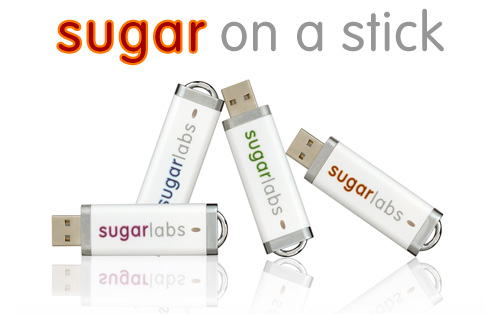Sugar on a Stick/Strawberry
Sugar on a Stick - Strawberry
Release Notes - last update: 2009/06/23
This document provides instructions how to prepare a SoaS installation, but contains also a list of known issues and further information. If you need more detailed information, please check the SoaS wiki page.
Get it!
Windows Users
- Download the latest version of Fedora LiveUSB Creator and extract it: https://fedorahosted.org/liveusb-creator/
- Plug your USB Key in and launch LiveUSB Creator
- Select Sugar on a Stick v1 Strawberry in the drop-down menu on the right
- Set the slider to at least 160 MB (use more if you've a key with more space)
- Click Create Live USB and wait for the process to finish
- Eject the device using the Safely Remove Hardware screen
Linux Users
- Download the final version of SoaS: http://download.sugarlabs.org/soas/releases/soas-strawberry.iso
- Install the following three packages on your machine: syslinux isomd5sum cryptsetup
- Download this script to put the image on your USB key: LINK TO BE DONE
- Plug your USB key in and unmount it afterwards
- Execute the script with the following command as root:
Note: In this example, your USB device would be sdb! Adjust this before confirming the command, if necessary. Also, you might want to increase the home or overlay size if you have more than 1 GB of space.
./livecd-iso-to-disk.sh --overlay-size-mb 300 --home-size-mb 160 --delete-home --unencrypted-home soas-strawberry.iso /dev/sdb
Mac Users
- Mac users will need to have access to a Linux or Windows machine to prepare their USB key
- Create your SoaS as described above for the different systems
- Download the boot helper disk: http://download.sugarlabs.org/soas/releases/soas-boot.iso
- Put both the CD and the USB key in
- Turn the Mac on and press at the chime the "C" key
- It should boot from the CD and continue to use the USB key then
Note: This is an experimental method to run SoaS on a Mac. Not all hardware configurations might be supported, as it is also noted in the known issues section. If you run into issues, you might want to consider using a virtual machine.
Boot it!
- Set the option to boot from USB in your machine's BIOS and let it come up
- If your machine doesn't support that, download and burn: http://download.sugarlabs.org/soas/releases/soas-boot.iso
- Make sure to name your USB key FEDORA, as it won't be recognized otherwise
- Put both the CD and the USB key in and let it boot from CD
Use it!
You have successfully installed Sugar on a Stick - now you can explore it. If you are interested in a guide for Sugar, you might want to check this: http://en.flossmanuals.net/sugar
Help Us
Please share your feedback with us - it helps us to improve following versions of SoaS. You can always send an e-mail to our feedback address feedback@sugarlabs.org or join the It's an Education Project mailing list: http://lists.sugarlabs.org/listinfo/iaep
If you encounter any hardware related issues besides the ones listed below, please consider joining our hardware effort. There, you will be able to submit the specs of your hardware, so that we can look better into it and work together with upstream to resolve issues.
Finally, you might also submit a bug report at our bug tracker, for which you would need an account.
Known Issues
As Sugar on a Stick is based on Fedora, namely the latest release - Fedora 11, it also contains a number of known issues, which should be mentioned. Recently, problems with ATI graphics hardware, as well as various Mac models have been reported. This was resolved by adding the nomodeset parameter to the kernel arguments. If you encounter image flickering or are not able to get past a black screen, it might be worth pressing ESCAPE at the blue screen, which appears for a second before the normal boot process starts. You'll be presented a short menu, at which you can directly press TAB - just add the nomodeset argument then in the appearing line and boot with ENTER.
